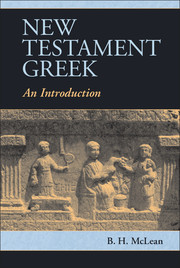Book contents
- Frontmatter
- Contents
- Abbreviations
- Introduction
- 1. Alphabet and Pronunciation
- 2. Writing Greek Letters, Accents, Diacritical Marks, and Punctuation
- 3. Present and Future Active Indicative, Present Active Indicative of the Verb “to be,” and Particles
- 4. Contract Verbs, Present and Future Active Indicative, and Future Indicative of Liquid Verbs
- 5. Second Declension, the Definite Article, and Prepositions
- 6. First Declension and the Definite Article
- 7. Adjectives, Demonstrative Pronouns, and Comparison
- 8. Personal Pronouns, Relative Pronouns, and Reflexive Pronouns
- 9. First Aorist Active Indicative
- 10. Verbal Roots, Principal Parts, and Second Aorist Active Indicative
- 11. Present Middle and Passive Indicative, Future Middle Indicative, and Future Indicative of the Verb “to be”
- 12. Imperfect Active Indicative and Imperfect of the Verb “to be”
- 13. Imperfect Middle and Passive Indicative and First and Second Aorist Middle Indicative
- 14. Third Declension Nouns and Adjectives: Part 1
- 15. Third Declension Nouns and Adjectives: Part 2
- 16. Perfect and Pluperfect Active, Middle, and Passive Indicative
- 17. Aorist Passive and Future Passive Indicative
- 18. Present and Aorist Participles
- 19. Aorist Passive Participle, Perfect Participle, Adverbial Participles, Genitive Absolute, and Periphrastic Constructions
- 20. The Athematic Conjugation (-μι verbs): Part 1 – The Indicative Mood
- 21. The Athematic Conjugation (-μι verbs): Part 2 – δείκνυμι, ϕημί, and Participles
- 22. Subjunctive Mood and Conditional Sentences
- 23. The Infinitive
- 24. Imperative Mood
- Appendix 1. Principal Parts of the Greek Verb
- Appendix 2. Summary of Paradigms
- Summary of Vocabulary to Be Memorized
- Subject Index
- Index of Greek Words Discussed
- Lexicon of Greek Words in Texts for Translation
2. - Writing Greek Letters, Accents, Diacritical Marks, and Punctuation
Published online by Cambridge University Press: 05 June 2012
- Frontmatter
- Contents
- Abbreviations
- Introduction
- 1. Alphabet and Pronunciation
- 2. Writing Greek Letters, Accents, Diacritical Marks, and Punctuation
- 3. Present and Future Active Indicative, Present Active Indicative of the Verb “to be,” and Particles
- 4. Contract Verbs, Present and Future Active Indicative, and Future Indicative of Liquid Verbs
- 5. Second Declension, the Definite Article, and Prepositions
- 6. First Declension and the Definite Article
- 7. Adjectives, Demonstrative Pronouns, and Comparison
- 8. Personal Pronouns, Relative Pronouns, and Reflexive Pronouns
- 9. First Aorist Active Indicative
- 10. Verbal Roots, Principal Parts, and Second Aorist Active Indicative
- 11. Present Middle and Passive Indicative, Future Middle Indicative, and Future Indicative of the Verb “to be”
- 12. Imperfect Active Indicative and Imperfect of the Verb “to be”
- 13. Imperfect Middle and Passive Indicative and First and Second Aorist Middle Indicative
- 14. Third Declension Nouns and Adjectives: Part 1
- 15. Third Declension Nouns and Adjectives: Part 2
- 16. Perfect and Pluperfect Active, Middle, and Passive Indicative
- 17. Aorist Passive and Future Passive Indicative
- 18. Present and Aorist Participles
- 19. Aorist Passive Participle, Perfect Participle, Adverbial Participles, Genitive Absolute, and Periphrastic Constructions
- 20. The Athematic Conjugation (-μι verbs): Part 1 – The Indicative Mood
- 21. The Athematic Conjugation (-μι verbs): Part 2 – δείκνυμι, ϕημί, and Participles
- 22. Subjunctive Mood and Conditional Sentences
- 23. The Infinitive
- 24. Imperative Mood
- Appendix 1. Principal Parts of the Greek Verb
- Appendix 2. Summary of Paradigms
- Summary of Vocabulary to Be Memorized
- Subject Index
- Index of Greek Words Discussed
- Lexicon of Greek Words in Texts for Translation
Summary
Given the similarities between Greek letters and English letters, it is important to note any important differences between them. In some cases, superficial resemblances can lead to significant errors. Writing Greek letters clearly is also an important aid to memorization. The following guidelines will help you form your letters correctly, especially in those cases in which a given Greek letter bears a strong resemblance to the Latin (English) letters you already know:
Not all Greek letters are the same height. Parts of the following letters are written below the line: β γ ζ η μ ξ ρ ϕ χ ψ ς.
Greek β should be made with one continuous stroke in contrast to English “b,” which is made with two strokes.
Never dot an ι (iota) and make sure it curls up at the bottom, unlike English “i.”
Greek κ should be half the height of English “k.”
Carefully form η to distinguish it from English “n.”
Carefully form ν to distinguish it from Greek υ and English “v.”
ξ is written below the bottom line.
Carefully form ρ to distinguish it from English “p,” which is made with two strokes.
Carefully form medial σ to distinguish it from Greek ο.
Carefully form Greek τ to distinguish it from English “t,” which is taller.
Carefully form the Greek letter υ, which is made with one stroke, not two. This will help you distinguish it from the English “u,” which is made with two strokes.
The Iota Subscript
A small ι is sometimes written under the vowels α, η, or ω, especially when they are final. This small ι is known as an iota subscript because it is written below (i.e., sub) the vowel. This iota subscript does not affect pronunciation. Vowels with an iota subscript are pronounced in the same way as the corresponding vowel without an iota subscript.
- Type
- Chapter
- Information
- New Testament GreekAn Introduction, pp. 19 - 26Publisher: Cambridge University PressPrint publication year: 2011



